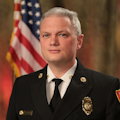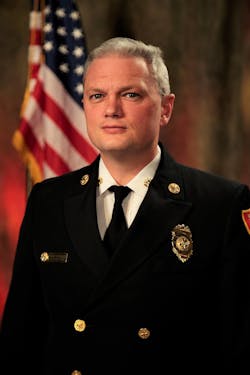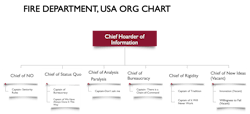Since the inception of the fire service, we have been challenged to effectively communicate. The absolute fundamental challenge every firefighter and fire chief faces is organizational communication.
Most of us rely on a command-and-control model for disseminating essential messages to the troops. Chiefs expect that critical information will be distributed through the chain of command, verbatim and with a particular intent. Our hierarchical charts have evolved into a highly technical map that resembles an electrical schematic instead of the original intent of illustrating a decision-making process. The organizations that rely on the chain-of-command method to communicate eventually fail, miserably.
In today’s globally connected world, traditional command-and-control fire service hierarchies are impediments to innovation, improvement and even firefighter safety. The hierarchical way of passing information from the chief to assistants, deputies, divisions, battalions, captains, lieutenants and finally to the person who needs it, is built to fail with our highly technical and computer-savvy generation(s) of employees. As our industry’s workplaces become more connected and more diverse, fire service leaders should recognize that their organizations are very complex, interconnected and dynamic living organisms that thrive on information. As such, the proverbial chain of command should be reserved for making decisions, not for limiting formal internal communication. The traditional, hierarchical organizational chart should only reflect and identify decision rights and responsibilities. Communication—including information about the organization, questions and concerns—should go anywhere, anytime.We must move away from traditional command-and-control leadership and toward one of shared responsibility, mutual accountability and open communication. New models are needed because most traditional approaches were not developed for 21st-century realities. This transition neither leads to a lack of discipline, nor does it threaten an officer’s authority. It is instilled in a joint vision, based on trust and deeply rooted in a strategic direction from every rank and job in the organization—and the lack of fear to discuss it.
A large body of research suggests that despite our belief of being a traditional para-military group, the fire service is a much more complex organization. The world around us has changed, and we have a critical need to adapt our practices to improve our ability to communicate, become more resilient and adapt successfully.
How to make the change
First, we need to change how we view information. Information is not a commodity to be controlled but instead, it is something that emerges and flows spontaneously, yet professionally, and without restriction when we interact with each other. Healthy fire service organizations facilitate a free flow of information to all members with the highest level of trust that communication will remain professional and discourage rumor mongering. Constant communication, encouraging discussions and the use of technology as much as possible, are tools that leverage a leader’s ability to share.
Second, selecting leaders that possess a wide range of personal and professional backgrounds is also viewed as a strength because it allows people of different perspectives to join in forming new ideas from all ranks. We can exploit this “cognitive diversity” to make better sense of emerging events and reduce groupthink that can occur around a kitchen table when there is a lack of information. In the absence of information, all of us can easily get caught in the trap of inventing our reality and the drama that comes with it.
Both the structural, or lack thereof, flow of information and our cognitive diversity are critically important in organizations if they are to survive. Removing the hierarchical chart for communication is a 21st century solution for 21st century needs. It inspires transformation, participation and collaboration, as well as conveys passionate commitment. By offering an equal partnership with information, leaders enable openness, transparency, collaboration, accountability and empowerment at all levels.
References
Ashmos, D., Huonker, J., & McDaniel, R. (1998). Participation as a complicating mechanism: The effect of clinical professional and middle manager participation on hospital performance. Health Care Management Review, 23, 7-20.
Eisenhardt, K. M., Kahwajy, J. L., & Bourgeois III, L. J. (1997). Conflict and strategic choice: How top management teams disagree. California Management Review, 39, 42-61.
McDaniel, R., & Walls, M. (1997). Diversity as a management strategy for organizations: A view through the lens of chaos and quantum theories. Journal of Management Inquiry, 6, 371-383.
About the Author

Brian Schaeffer
Brian Schaeffer is the fire chief for the Spokane, WA, Fire Department. His professional life spans more than 30 years in fire departments in the Midwest and Pacific Northwest. Schaeffer serves on numerous local, state, and national public safety and health-related committees. He frequently lectures on issues that involve innovation, leadership and public safety technology. Schaeffer is a member of the Firehouse Editorial Advisory Board.

